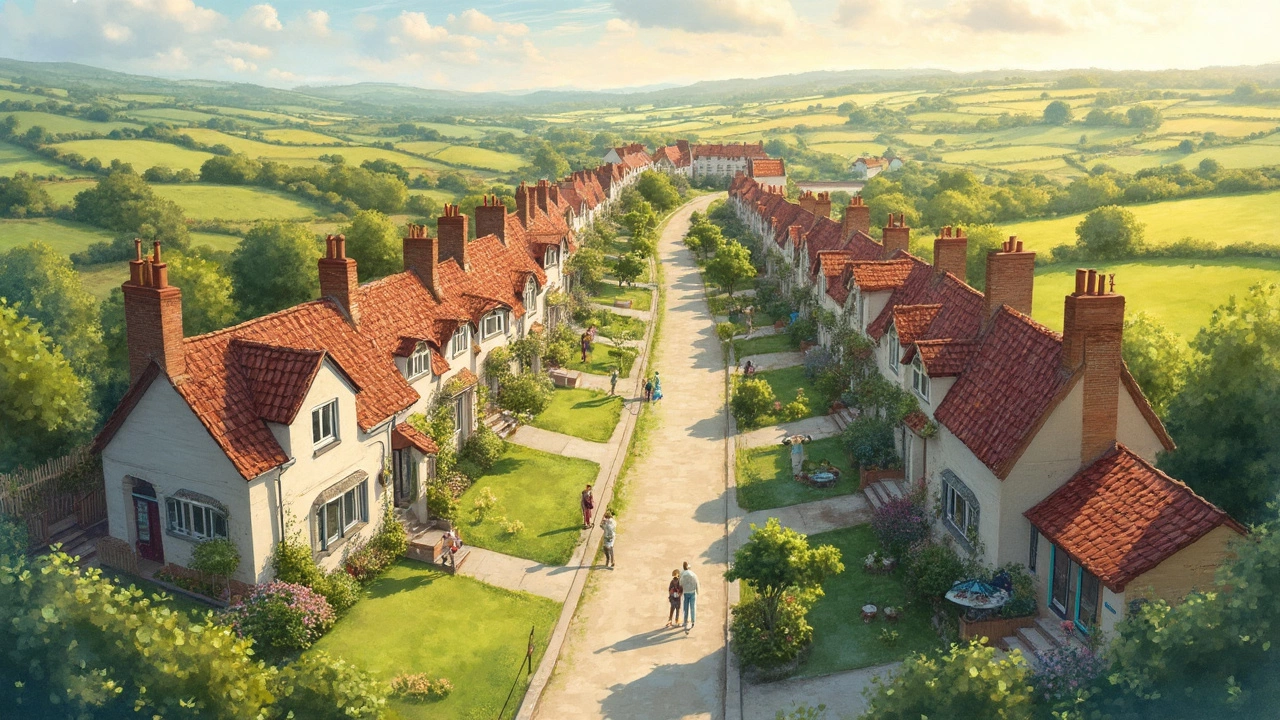Can I Afford a House on 40k a Year?
 Apr, 14 2025
Apr, 14 2025
Dreaming of owning a house but only making 40k a year? It might seem like a long shot, but buying a home isn’t just for the super-rich. Yeah, wages in Sydney aren’t always sky-high, but there are clever ways to make it happen. Let’s start by figuring out what kind of budget you're working with. It’s all about crunching numbers and seeing how much you're comfortable parting with each month.
Banks usually look at something called the debt-to-income ratio. This basically means how much of your pay is used to cover your debts. Keeping it below 30% is a good shout, meaning if you’re bringing in 40k, your total debt payments shouldn’t exceed $1,000 a month. If you already have debts, pay them down or consolidate if you can, freeing up more cash for housing costs.
On top of that, you’ve got to think about your down payment. While the golden rule used to be 20%, there are ways to get by with even less. Consider saving up through a high-yield savings account. You'll still earn interest and save a bit more without doing anything different. Also, tap into grants or first-time homebuyer programs that might help you out with that initial chunk of change.
- Understanding Your Budget
- Saving Smart for a Down Payment
- Exploring Affordable Housing Markets
- Assistance Programs and Grants
- Strategies for Keeping Costs Low
Understanding Your Budget
Alright, let's get down to brass tacks. Grabbing your dream house while earning 40k a year means you've got to be tight with your pennies. The first thing on your checklist should be to map out a clear budget. Start by listing out all your monthly expenses. This isn’t just your rent or mortgage; think utility bills, groceries, and any standing debts.
A good rule of thumb is the 50/30/20 method. Here's the lowdown: 50% of your take-home pay should go to needs like housing and bills. Another 30% is for wants—we're talking coffee treats, streaming services. Save the last 20% for reducing debts and future savings. But let's face it, in home-buying mode, saving a bit more can speed things up.
Another key step is settling on a price range for your new home. The general advice? Don’t spend more than three times your annual income on a house. At 40k, that means aiming for homes around 120k, but that may swing based on other expenses and existing cash flow.
Now, to put it all into perspective, check out this handy table that breaks down how much house you can afford at different interest rates when on a 40k income:
| Interest Rate | Max House Price | Monthly Payment |
|---|---|---|
| 3% | $150,000 | $632 |
| 4% | $135,000 | $648 |
| 5% | $122,000 | $656 |
Remember, these numbers can change based on local taxes and insurance, so use them as a baseline. Keeping an eye out for varying interest rates can be the difference between settling for a cozy flat and landing that sweet suburban house.
By tweaking your budget and setting it in stone, you'll have a clear road map to make your home-buying journey smoother. It's all about knowing your limits and sticking to them. Once you're set, you’ll have a much easier time planning for that first-time home purchase.
Saving Smart for a Down Payment
Getting that down payment together can seem like a massive hurdle, especially on a 40k salary. But don't let it get you down – with some smart strategies, you can get there. First off, aim for a realistic down payment goal. While 20% is the gold standard, many options today only require 3% to 5%. That can make a huge difference.
Start by setting up a dedicated savings account just for your down payment. It helps keep you disciplined and makes tracking progress easier. Look for a high-yield savings account to get a bit more return without any extra effort. Every little bit helps when you're saving tightly.
If it's in the cards, cutting down on unnecessary expenses can free up more cash. Maybe ditch that gym membership you don't use or try cooking at home more often instead of ordering out. Redirect those savings straight into your down payment fund and watch it grow faster than you'd think possible.
Check out assistance programs available in your area. Some of them can offer thousands of dollars that could be put toward your down payment. Often, first-time homebuyer credits or grants are available if you qualify. It's worth the research time for the potential payoff.
Here’s a simple look at what a 3% and 5% down payment might look on typical home prices:
| Home Price | 3% Down Payment | 5% Down Payment |
|---|---|---|
| $300,000 | $9,000 | $15,000 |
| $350,000 | $10,500 | $17,500 |
So, yeah, it might feel overwhelming, but starting early and staying consistent will turn that house dream into a reality. Focus on these small steps and check out those first-time homebuyer options in your area. Make your money work smarter for you!

Exploring Affordable Housing Markets
So, you’re living on a 40k salary and thinking about buying a home. Don’t sweat it! Australia’s housing market isn’t only for those with six-figure incomes. You just need to know where to look for those hidden gems that are still within reach.
First up, let’s talk about location. If you’re flexible with where you lay your head at night, consider broadening your search area. Places like Bendigo in Victoria or Toowoomba in Queensland offer more bang for your buck than being right in the heart of Sydney. These areas have seen growth but still keep housing at a reasonable price, making them fantastic options for first time home buyers.
For example, a decent property in Armidale could set you back significantly less compared to the steep costs in the inner city. Plus, these areas often come with lower living costs across the board, which leaves more room in your budget for loan payments.
You might not know this, but some regions offer incentives to move there. Keep an eye out for government-backed schemes that aim to attract new residents by offering reduced property taxes or grants, especially in regional or rural areas.
If you're considering buying a house as an investment, look at future developments in infrastructure or local job markets. Areas with new public transport links or businesses can see property values shoot up, giving you more reason to settle there.
Just remember, taking the time to research can make a world of difference. Check out local forums or Facebook groups for insights into up-and-coming neighborhoods or market trends. With the right move, you could find yourself not just with a home, but a solid investment for the future.
Assistance Programs and Grants
Alright, so you're thinking of buying a home and wondering if there's any extra help out there. Good news! Australia has a bunch of assistance programs and grants to help make it less painful for folks like us. Whether you're eyeing something in Sydney or maybe a quieter spot, there's something for everyone.
First up, there's the First Home Owner's Grant (FHOG). This thing can be a real lifesaver. Depending on the state you’re buying in, you might snag up to $10,000 or even more if you’re building a new home. But heads up, there are some conditions, like the property price cap and if you're getting a newly built place.
Then, there's the First Home Loan Deposit Scheme (FHLDS). This one's pretty sweet if you don’t have a huge deposit saved up. Normally, if you've got less than a 20% deposit, you end up paying for Lenders Mortgage Insurance (LMI). But with the FHLDS, you might only need 5% deposit and skip the LMI cost through the government's backing.
If you're living in community housing or looking at non-private options, check out other potential grants or subsidies specific to your area. States and territories often have unique perks, so it's worth a look.
For those diving into the low deposit route, a comparison could be handy:
| Program | Deposit Required | Potential Benefit |
|---|---|---|
| FHOG | Varies | $10,000+ |
| FHLDS | 5% | No LMI |
Finally, remember that eligibility varies. Check out your state’s revenue office or resources online to see what specific programs are there for your situation.

Strategies for Keeping Costs Low
So, you're ready to jump into the home-buying game, but sticking to a budget is key, especially when trying to make a first time home buyer plan work on a tight income. Let's see how you can keep those costs from spiraling out of control.
First thing’s first, think about the location. You don't need a flashy address to find a comfortable place to live. Consider looking in neighborhoods that are up and coming. They often offer lower prices now but have the potential to grow in value over time.
Now, let's talk about the bones of the house. Fancy fixtures can be cool, but they’ll tack on extra costs. Stick with homes that need minor updates you can handle yourself. Doing your own improvements over time can save a ton.
Another trick? Shop around for loans. Don't just go with the first one you hear about. Compare different mortgage rates and terms to make sure you're not paying more than you need to over the long haul. Ask around about local banks and credit unions—they might have better deals for low income housing.
Let's not forget about negotiating. Whether it’s the purchase price or the closing costs, there's often some wiggle room. Hiring a savvy real estate agent can really help here, and they might save you more than they're costing.
Lastly, think about energy efficiency. A home's running cost isn't just your mortgage. Look for features like good insulation, energy-efficient appliances, and solar panels. These might require a little more upfront, but they'll reduce your monthly bills, helping you keep costs low in the long run.
Keeping costs down is a balance between being prepared and staying flexible. With a bit of effort, even a 40k a year salary can stretch a lot further than you might expect, turning your home-owning dreams into reality.